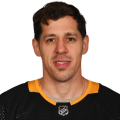Fantasy Hockey Lessons Learned: Biggest takeaways to carry with you next season
Fading goalies early and targeting undervalued defensemen late are two of the biggest lessons to remember for next fantasy hockey season.
One of the most neglected aspects of fantasy hockey is taking a moment when the season has ended to evaluate what has transpired over the last seven months.
We can use this period of review to determine the most important takeaways that will be useful to remember when next season rolls around. After taking some time to reflect, I’ve come up with five takeaways of my own from this past season to share. Let’s dig in:
Goalies are always streamable
Another year, another win for the #ZeroG strategy. While high picks like Igor Shesterkin, Andrei Vasilevskiy, and Ilya Sorokin performed well, there were once again huge performances from goaltenders like Linus Ullmark, Alexandar Georgiev and Filip Gustavsson who were all drafted past pick No. 100 in Yahoo ADP (if they were drafted at all). Of the top 10 goaltenders by games played, only two (Juuse Saros and Georgiev) improved their save percentage from the first half of the season to the second. With the opportunity cost of those top goaltenders being so high, the simplest play remains to take multiple shots on goalies late in your draft and continue to ride hot hands throughout the season.
Focus on cheap No. 1 defensemen late
One trend I’ve paid particular attention to this year is the emergence of several defensemen from the depths of the ranks to elite fantasy status. Erik Karlsson, Josh Morrissey and Vince Dunn all emerged from the 12th round or later by ADP to post incredible fantasy seasons. Next year, I’ll be very interested in zeroing in on several of the defensemen who fit this profile late in my drafts. The common thread here is that all three were clear No. 1 defensemen with near-certain PP1 usage that provided them the opportunity ceiling necessary to reach these heights. Come September, I’ll be taking this bet on any number of defensemen who are a match on those two fronts.
Fading injury narratives remains profitable
Speaking of Karlsson, one of the biggest things holding down his ADP this past September was injury concern. I continue to believe that one of the most overblown reasons fantasy managers avoid certain players in their drafts is the “injury-prone” label. If you faded that narrative on Karlsson and others like Evgeni Malkin, you were rewarded with consistent production that far outperformed the cost to acquire. I’ll be watching to see if similar discounts emerge in drafts next season on players like Cale Makar and Filip Forsberg and I’ll be first in line to scoop those profits up. After all, even when they’re injured you still get to play someone else. Worst case I’ll take 70 games of elite production from Makar and 12 games of replacement-level production from a waiver wire add.

Don’t hold on to the past
One of the biggest mistakes I see fantasy managers make year after year is hanging onto players long after they’ve stopped providing anything meaningful for your fantasy team. If you rostered Mats Zuccarello in 2022, you were loving life with his 16 goals and 40 points in 36 games. But after New Year’s hit, Zuccarello recorded just six goals and 27 points in 42 games to close out the season, a massive drop in production. It’s extremely important to avoid double-counting a player’s past production when considering what they’re likely to offer your fantasy squad moving forward. So keep checking in on your early breakout darling (looking at you, Dominik Kubalik) and don’t be afraid to move on if the present isn’t matching up with the past.
The biggest breakouts come from team improvements
I think one of the more interesting revelations I’ve had this year is that predicting a team-wide context might just be the key to projecting potential breakouts. What do Tim Stützle, Tage Thompson, Jason Robertson and Jack Hughes all have in common? Each of their teams scored at least 35 more goals this season than last. Of these players’ respective teams, both Ottawa and New Jersey were trendy candidates to take a step forward this year, at least offensively. The Stars exploded offensively under new coaching. Buffalo may have been the hardest team to predict to take the step that they did, but that’s not going to stop me from trying to isolate at least two or three teams next year I think have made moves that could lead to vastly improved offensive environments for their fantasy-relevant players.
I hope these takeaways have given you something to think about this offseason, and don’t worry: soon it’ll be September again and we’ll be drafting our teams for the 2023-24 season. Just no goalies early in those drafts, ok?
Nate Groot Nibbelink is the creator of Apples & Ginos Fantasy Hockey and the originator of the #ZeroG draft strategy. You can find him pontificating about obscure fantasy hockey strategy topics in the Apples & Ginos Discord Server or on Twitter @applesginos.


